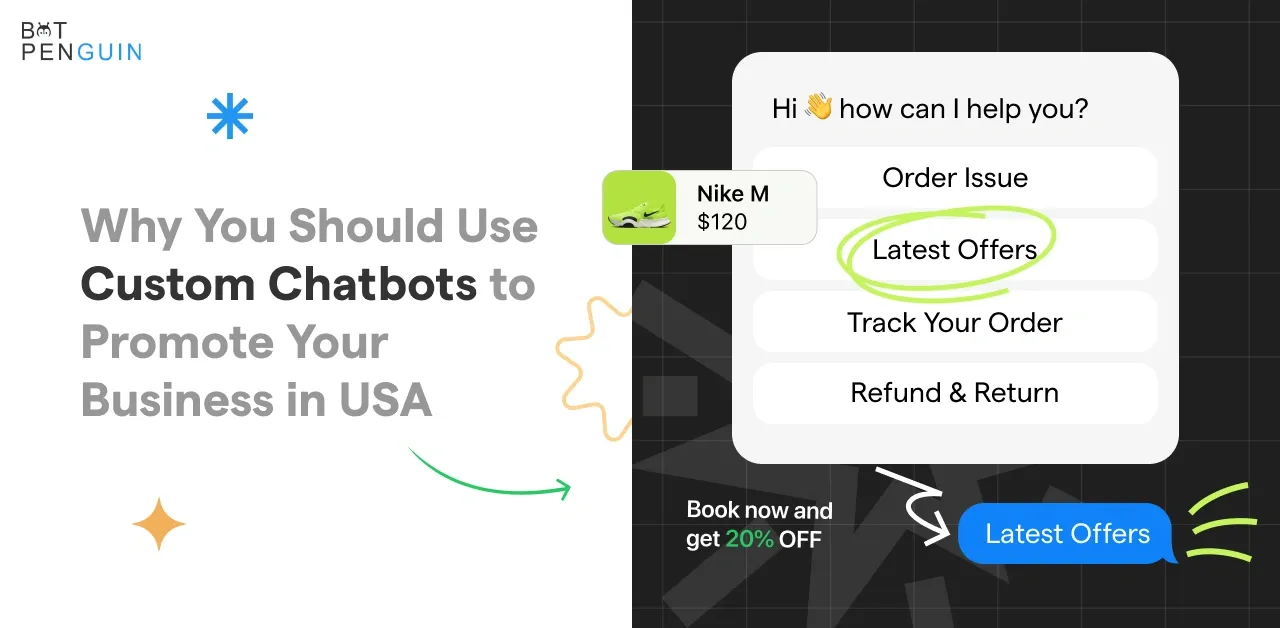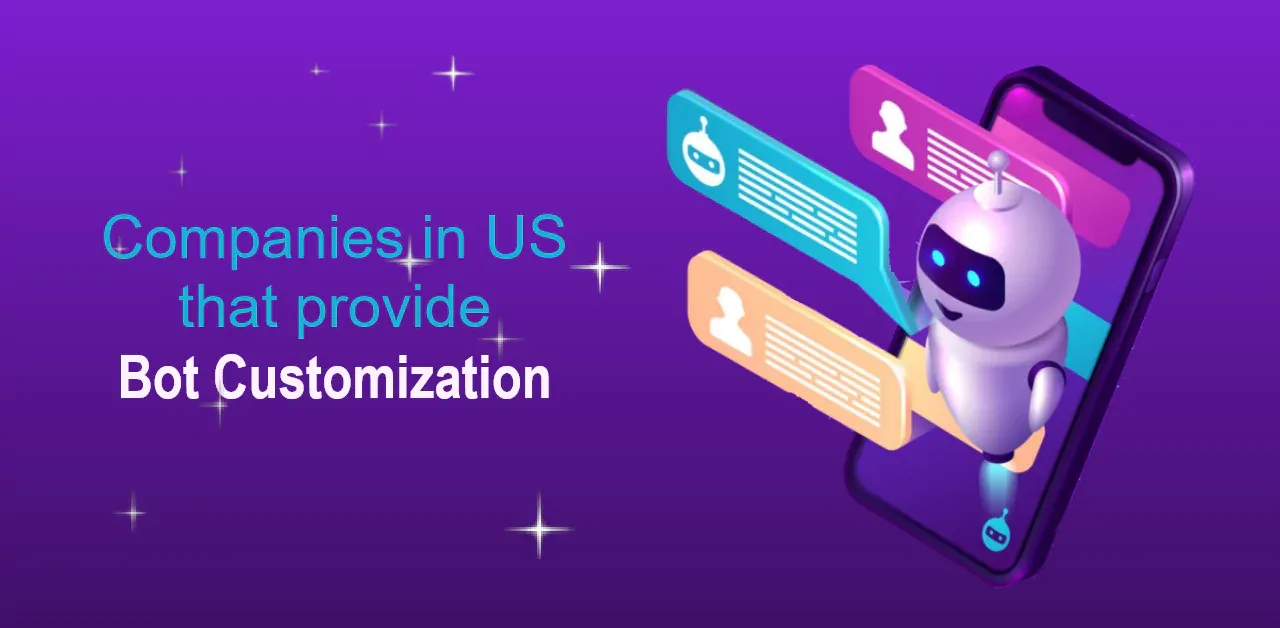Introduction
The ultimate showdown in AI interactions is Voicebot development vs Chatbot development! In an era where ease of access and swift communication reign supreme, the debate between voicebot development vs chatbot development rages on. Imagine choosing between a smooth, hands-free conversation and a text-based chat with your digital assistant. Voicebots bring a touch of modern convenience, allowing you to interact through speech, while chatbots offer the precision and structure of text.
As businesses seek the most effective and efficient means to engage their customers, understanding the intrinsic differences between the two can serve as a critical factor in deciding which bot serves their needs best.
In this article, we'll explore the exciting features, use cases, and unique benefits of Voicebot Development vs Chatbot Development. Whether you're drawn to the immediate, conversational style of voicebots or the detailed, text-driven approach of chatbots, understanding these differences will help you decide which AI development path suits your needs best. Buckle up as we dive into the world of Voicebot Development vs Chatbot Development and discover how each can elevate your digital interactions!
So without further ado, let's begin!
What's a Chatbot?
A chatbot is an AI-driven tool designed to simulate human conversation, typically through text-based interactions. It can be integrated into websites, messaging apps, or customer service platforms to handle routine inquiries, provide information, and guide users through various processes.
Chatbots use natural language processing (NLP) to understand and respond to user queries in real time, offering a seamless and efficient way to engage with customers.
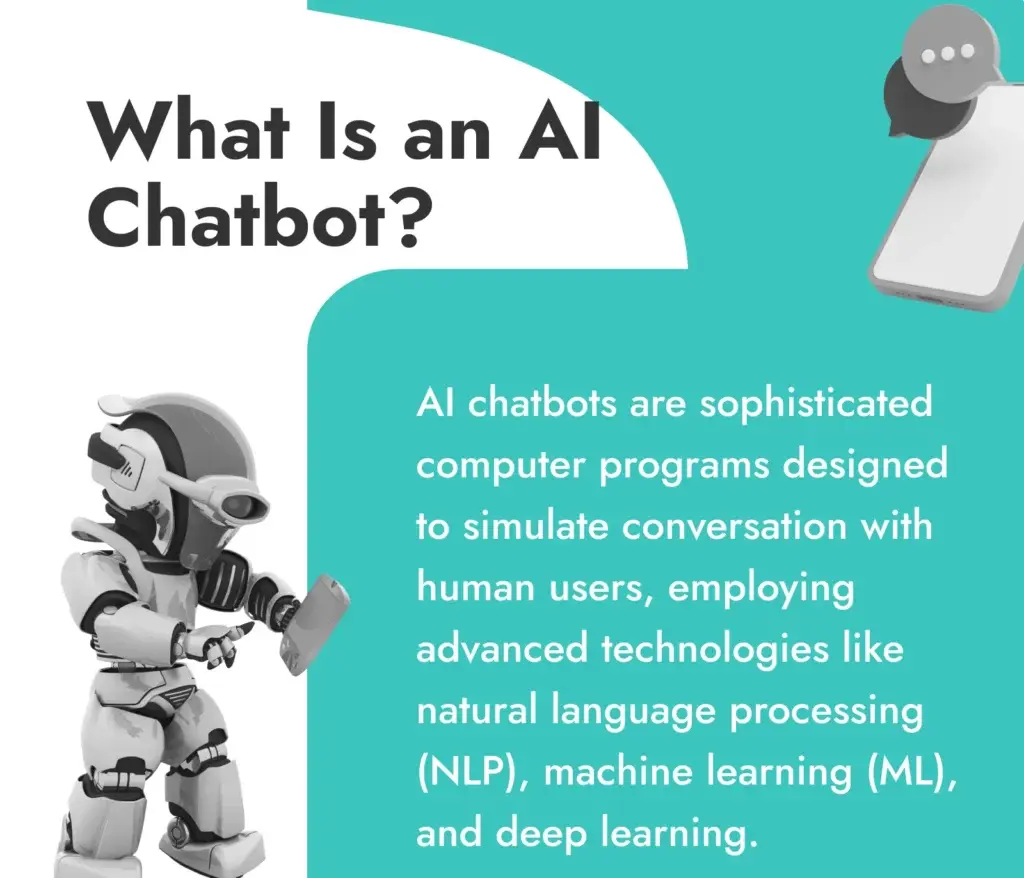
They can range from simple rule-based systems to more advanced AI chatbots that learn and adapt over time, enhancing their ability to handle complex interactions and deliver personalized experiences.
What's a Voicebot?
A voicebot is an AI-powered virtual assistant that interacts with users through spoken language. Unlike chatbots, which use text, voicebots utilize speech recognition and natural language processing (NLP) to understand and respond to vocal commands.
They are commonly integrated into devices like smartphones, smart speakers, and customer service systems, allowing users to perform tasks, get information, or control other applications hands-free.
Voicebots can handle a range of functions from answering questions and providing recommendations to completing transactions and managing schedules, offering a more natural and conversational user experience.
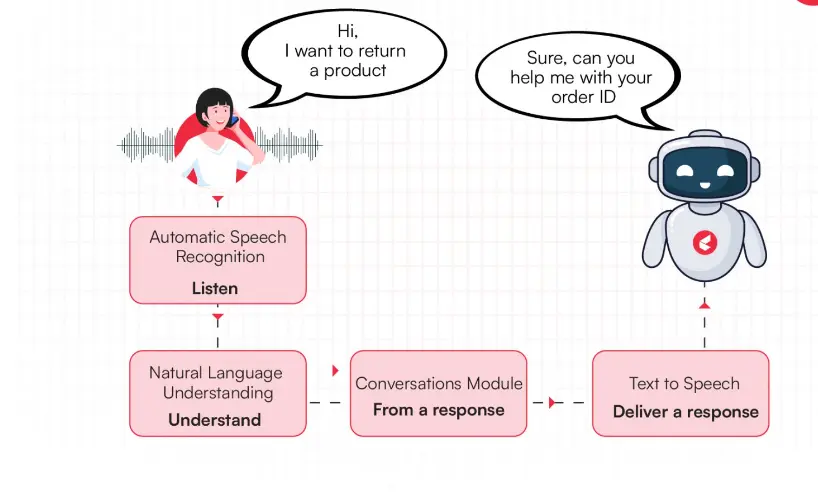
Head-to-Head: Voicebot development vs Chatbot development
As we delve deep into voicebot development vs chatbot development, let's compare key features of voicebots and chatbots that may sway your development choice.
Suggested Reading:Voicebots in action: Real-world examples & best practices
Communication Style (Text vs. Speech)
Communication style marks a significant point of divergence. Chatbots excel in environments where typing is more viable, whereas voicebots represent the go-to in scenarios demanding verbal interaction; think driving or cooking.
When comparing communication styles, chatbots use text-based interactions, which are ideal for written queries and responses. This method allows users to read and review information at their own pace.
In contrast, voice bots utilize speech, enabling hands-free, natural conversations and immediate responses. Voice interactions can be more intuitive and accessible, particularly for multitasking or visually impaired users.
While chatbots offer clarity through text, voicebots provide a more conversational and personal touch, enhancing user engagement through spoken dialogue.
Suggested Reading:Voicebot vs. Chatbot: Which Bot should you choose?
User Experience (Hands-Free vs. Text-Based)
User experience is central to any tech decision. Voicebots offer a hands-free approach ideal for users on the go, while chatbots might be preferred for confidentiality, silent environments, or simply out of habit.
In terms of user experience, voicebots offer a hands-free, conversational approach, making interactions more natural and immediate. This is ideal for multitasking or for users who prefer speaking over typing.
On the other hand in Voicebot Development vs Chatbot Development, chatbots provide a text-based interface that allows users to review and process information at their own pace. While chatbots are excellent for detailed queries and structured interactions, they lack the immediate, conversational ease that voicebots deliver.
Suggested reading:Building Voice-First UX: Strategies for Voicebot Development
Complexity of Tasks (Simple vs. Multi-Step)
When it comes to managing tasks, chatbots and voicebots have different approaches. Chatbots handle complex, multi-step processes adeptly with structures such as menus and buttons. Voicebots shine in performing straightforward tasks quickly.
When it comes to task complexity, chatbots are generally better suited for handling multi-step processes. Their text-based nature allows users to navigate through detailed workflows and provide step-by-step instructions.
This is ideal for tasks requiring multiple inputs or detailed information. Voicebots, while excellent for simple, quick commands or single-step interactions, may struggle with more complex tasks that involve several steps or require detailed explanations.
Accessibility (Visually Impaired Users)
For accessibility, voicebots have a distinct advantage over chatbots, especially for visually impaired users. Voicebots enable hands-free interaction through spoken commands, which is more inclusive for those who cannot easily read or type text.
This auditory interface allows users to engage with technology without visual cues. In contrast, chatbots rely on text, which can be challenging for visually impaired individuals unless paired with screen readers or other assistive technologies.
Voicebots offer a more natural and accessible user experience for those with visual impairments, facilitating smoother and more intuitive interactions.
Response Speed (Instant vs. Delayed)
Voicebots typically offer near-instantaneous responses, thanks to their real-time speech processing capabilities. This immediacy makes interactions feel more natural and fluid, ideal for users seeking quick answers or engaging in rapid conversations.
In contrast of Voicebot Development vs Chatbot Development, chatbots may experience slight delays due to the time it takes to type out and read text responses. While this delay is often minimal, it can impact the immediacy of user interactions, particularly in time-sensitive scenarios.
Voicebots excel in providing swift, seamless communication, while chatbots offer a more deliberate, text-based exchange that can sometimes feel less immediate.
Suggested Reading:A Complete Guide to Chatbot Development
Data Privacy and Security (Text-Based Logs vs. Voice Data)
Chatbots handle interactions through text-based logs, which can be encrypted and stored securely. These logs provide a clear record of interactions that can be reviewed for security and compliance purposes. However, managing and protecting this data requires robust security measures to prevent breaches.
Voicebots, on the other hand, process and store voice data, which poses unique privacy challenges. Voice recordings are subject to stringent regulations and need secure handling to protect sensitive information.
Ensuring that voice data is anonymized and encrypted is crucial to maintaining user privacy and meeting legal standards. Both approaches require strong security practices, but voice data introduces additional complexities in safeguarding user information.
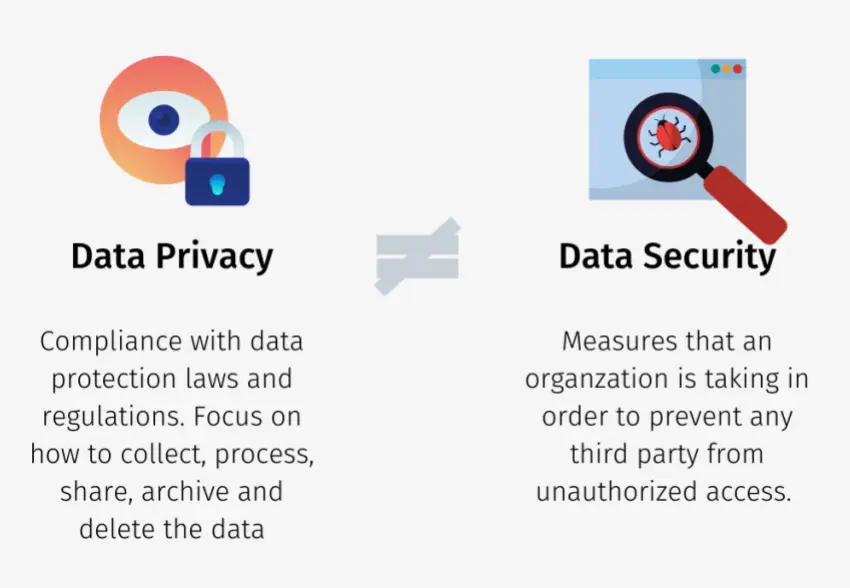
Picking Your Champion In Voicebot Development vs Chatbot Development: When to Choose a Voicebot
In the voicebot development vs chatbot development arena, there are moments when voicebots definitively take the lead.
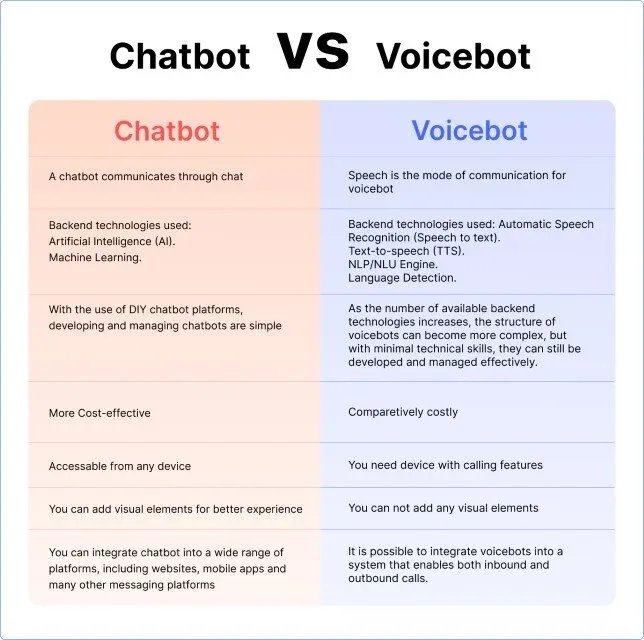
Situations Calling for Voicebots (Hands-Free Interaction)
Voicebot shines in environments requiring hands-free interaction, such as when users are engaged in physical tasks or driving, promoting safety and convenience.
Target Audience Prefers Voice Commands
If your target audience leans towards the enhanced engagement and simplicity that voice commands offer, a voicebot may serve as the best bridge between your services and their preferences.
Integration with Voice-Controlled Devices
Voicebots are the ideal match for ecosystems already governed by voice-controlled devices, ensuring a seamless experience across all user touchpoints.
Choosing the Text Titan Between Voicebot Development vs Chatbot Development: When a Chatbot Shines
Yet, there are scenarios in Voicebot Development vs Chatbot Development where chatbot development trumps voicebot integration. Let's see where chatbot shines in the voicebot development vs. chatbot development debate :
Text-Friendly Users (Comfortable Typing)
For audiences that favour privacy and are comfortable with typing, chatbots provide a more controlled and discreet way of interacting.
Complex Information Sharing (Visuals and Buttons)
Chatbots are your knight in shining armour when the task at hand requires detailed information exchanges, complete with the visual aids and clickable options that they can uniquely provide.
Multi-Channel Communication (Messaging Apps and Websites)
Their adaptability to websites and multiple messaging platforms makes chatbots an unparalleled ally when aiming to maintain a consistent presence across varied digital channels.
Building Your Voicebot: Development Platforms
There are several platforms available for you to build your voicebot:
Amazon Alexa Skills Kit
Amazon Alexa Skills Kit is a comprehensive suite of tools allowing developers to create customizable skills for the Alexa voice assistant, powering devices like Amazon Echo.
Google Dialogflow
Dialogflow by Google provides a user-friendly interface for creating conversational interfaces for voicebots, with natural language understanding and integration with the Google Assistant.
Microsoft Bot Framework
Part of Azure Bot Service, Microsoft Bot Framework offers tools for developing voice and chatbots that can communicate across multiple platforms, including Cortana.
IBM Watson Assistant
IBM Watson Assistant leverages AI to help build sophisticated voicebots capable of understanding context, processing natural language, and responding conversationally.
Rasa Open Source
Rasa is an open-source platform favored by developers for creating voicebots that require highly customized solutions, with advanced dialogue management and machine learning capabilities.
Building Your Chatbot: Development Platforms
There are several platforms available for you to build your chatbot:
BotPenguin
BotPenguin is an AI-powered chatbot development platform perfect for businesses of all sizes. It offers easy integration, lead generation, and multi-platform support.
MobileMonkey
MobileMonkey allows developers to build AI chatbots for a variety of platforms. It's great for marketing, with features like chat blasting and list building.
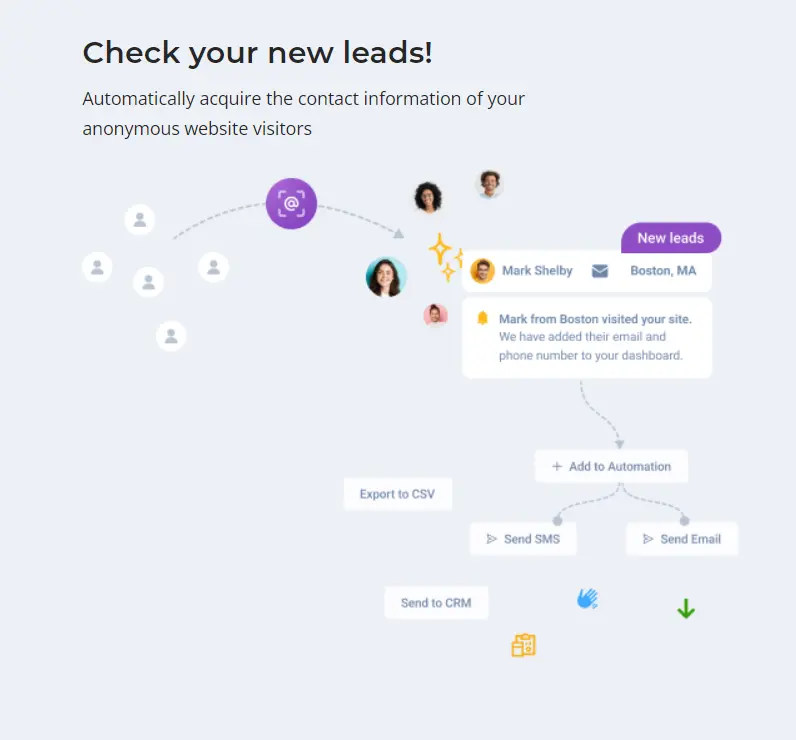
DialogFlow
Google's DialogFlow excels in natural language processing, letting you build chatbots that can understand and respond naturally to complex conversations.
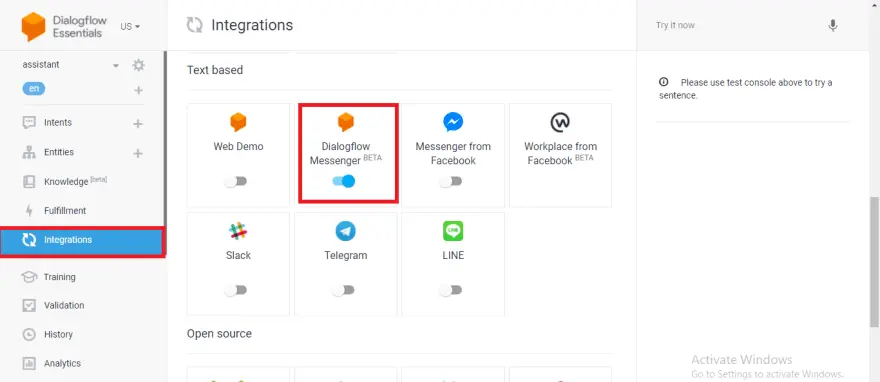
IBM Watson Assistant
IBM Watson Assistant stands out with robust AI, permitting the creation of chatbots that understand context, learn from interactions, and manage dialogues convincingly.
Here's a simple comparison table for Voicebot development vs Chatbot development
| Feature/Aspect | Voicebot | Chatbot |
|---|---|---|
| Communication Style | Speech-based; conversational and hands-free | Text-based; structured and readable |
| User Experience | Hands-free, natural conversation | Text input/output; requires typing and reading |
| Complexity of Tasks | Best for simple, single-step interactions | Handles complex, multi-step processes effectively |
| Accessibility | More accessible for visually impaired users | Requires screen readers or visual accessibility tools |
| Response Speed | Real-time, immediate responses | Slight delays due to text processing |
| Personalization | Adaptive, contextually relevant interactions | Static responses; limited personalization |
| Integration Capabilities | Integrates with voice-enabled devices and systems | Integrates with text-based platforms and CRM systems |
| Development Complexity | Higher complexity due to speech recognition and NLP | Generally less complex; text-based interactions |
| Cost Efficiency | Higher initial development costs; ongoing maintenance can be expensive | Typically lower development and maintenance costs |
| User Engagement | Engages through natural, conversational style | Engages through text; can be less engaging over time |
| Error Handling | Can struggle with mispronunciations or accents | Handles text-based errors through predefined responses |
| Data Privacy and Security | Requires secure handling of voice data; additional privacy considerations | Manages text logs with standard encryption; easier to audit |
This table offers a concise overview of the differences between Voicebot Development vs Chatbot Development. For more detailed information, it's important to research each of them with your use case in mind.
Suggested Reading:Advanced AI Chatbot Development: Top Use Cases & Benefits
Final Decision: Voicebot Development vs Chatbot Development
The choice between implementing a voicebot or a chatbot boils down to the specifics of the user interaction you aim to facilitate, the environment in which your users will interact with the bot, and the nature of tasks the bot is expected to perform.
Suppose your target user base is more likely to engage in environments where hands-free operation is necessary or preferred, such as while driving or cooking. In that case, a voicebot represents the most user-friendly option. Voicebots are also advantageous for users with visual impairments or those who are not comfortable typing.
Conversely, chatbots are more suited to scenarios where users can and prefer to read and type. They excel in situations where detailed information, such as links or documents, needs to be shared. Chatbots are also more appropriate for environments that require discretion or where silence is golden, as they do not necessitate speaking aloud.
The ultimate answer and decision lies with you and your use case at hand.
Conclusion
In conclusion, as technology evolves, the debate between Voicebot Development vs Chatbot Development will continue to be a significant focus.
Choosing between Voicebot Development vs Chatbot Development depends on your user behavior their preferred mode of communication and, most importantly, your business requirements. If vocal commands and hands-free operation align with your business goals and customer needs, a voicebot would be a superior choice.
Conversely, if your user base is more comfortable with typing and visual interactions, a chatbot might be the better option.
Voicebot Development offers a natural, conversational experience that feels like chatting with a tech-savvy friend, while Chatbot Development excels in managing complex tasks through detailed text interactions. Your decision between these options can significantly impact how you engage with users and streamline your operations.
Remember, don't be hesitant to experiment and evolve your strategies depending on technological advancements and AI capabilities. Lastly, whether you select a voicebot or a chatbot, make sure it provides an engaging, helpful, and fluid interaction that adds value to your user’s experience.
Frequently Asked Questions (FAQs)
What's the best strategy when creating a chatbot?
Start simple, focus on solving specific problems, and always design with your user's needs and behaviours in in mind. Iteration and feedback are your best friends.
What are the key differences between rule-based chatbots vs AI chatbots?
Rule-based chatbots follow predefined paths to solve problems. AI chatbots, however, learn from interactions, making them more adaptable and capable of handling complex conversations.
What are the benefits of Voicebot?
Voicebots offer hands-free convenience, making multitasking easier. They're also accessible, aiding those with visual impairments or literacy challenges to access information.
What makes it so difficult to build a good chatbot?
Creating a chatbot that understands diverse user inputs, maintains context, and provides meaningful interactions requires sophisticated AI and continuous refinement based on user feedback.
What is an example of a voice bot?
Amazon Alexa is a popular voicebot that assists with daily tasks, answers questions, controls smart home devices, and provides entertainment through voice commands.

